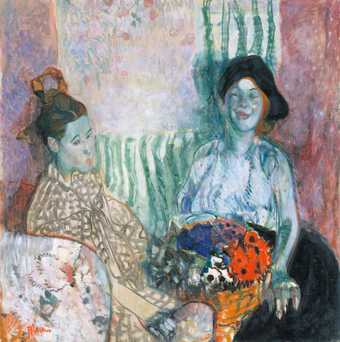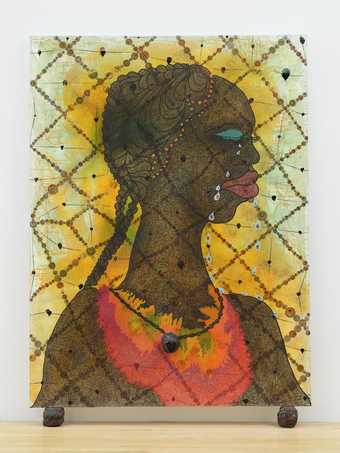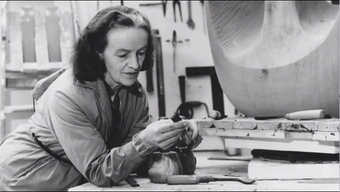Press play and discover the story behind Divided Circle (Two Forms) by Dame Barbara Hepworth. Hear a detailed description of the artwork and learn more about how the artist made the work.
Dame Barbara Hepworth Two Forms (Divided Circle) 1969
This is an audio description of the large bronze sculpture Two Forms (Divided Circle). It was created by British artist Dame Barbara Hepworth in 1969. It is displayed in the Sculpture Garden of the Barbara Hepworth Museum, the artist’s former home and studio in St Ives, Cornwall.
Two Forms features two tall, semi-circular bronze sections standing side-by-side to form a circle. Their straight inner edges face one another. These semi-circular sections are connected to a flat rectangular base at one pointed end. The base is fixed to a white-painted concrete plinth at ankle height. An inscription documents the maker’s name, and the London foundry – Morris Singer - where it was cast.
Each towering segment is over two metres tall, more than a metre wide and half a metre thick. They taper towards the bottom and their outer edges, and precariously overhang the base. The two segments are slightly angled, almost pulling apart with a gap between them. The gap is around 40 centimetres in the middle. It suggests a passage between the parts, but the gap is too narrow to enter. One segment is positioned a little behind the other. The overall effect is a sense of movement and poise. The gap becomes as important as the material sculpture.
Each section is pierced through the centre by a large circular hole. These openings allow views through, to the landscape beyond. Both holes are of different sizes and tunnel through the interior. They create a seamless contact between the interior and exterior of the sculpture. The sculpture can be viewed from different perspectives. However, for this description we will identify one side as ‘front facing’. This is the side you encounter as you enter the garden.
The front face of the left section is punctured by a hole slightly bigger than a dinner plate, set within a large oval recess. The egg-shaped recess occupies about two-thirds of the face and is pierced in the centre by the hole. From the rear of the sculpture, the edges of the circular hole emerge as an oval opening. The section on the right has a larger circular hole piercing its convex front face. Seen from the reverse, this hole appears embedded into a half-moon shaped recess.
The surface colour, or patina, of the sculpture is a green-grey tone. While the sides are smooth, their larger, slightly convex, faces bear the marks of carving of the original plaster, from which the bronze cast was made. The surface is marked with evenly distributed curving lines, scratches and groups of dotted indentations created by Hepworth and the tools she used. In contrast, the recessed areas are more golden and polished. These interior sections still display the texture of carving, but shine in the light and draw the viewer in.
Sculpture had traditionally been understood as an object existing in space. However Hepworth was interested in the idea of creating space inside an object and opening up the form. To do this, she hollowed out sculptures from blocks of stone and wood. In the mid 1950s, she developed a way of constructing large plaster forms that she could carve and then cast into bronze. It was all about space and inviting us to imagine ourselves inside her sculptural forms. Hepworth insisted that a person’s whole body should be engaged with the work.
She also talked about her sculptures being inspired by the moors and coastline: especially the stones, rocks and hollows of the rugged cliffs around St Ives. Also in the late 1960s, in a new era of space exploration, she was interested in the night sky. Two Forms contains half-moon shapes and shining circles that change constantly with the shifting light. Hepworth wrote : ‘So much depends, in sculpture, on what one wants to see through a hole! Maybe in a big work I want to see the sun or moon.’
Hepworth moved to St Ives at the beginning of the Second World War. She lived and worked there until her death in 1975. According to her wishes, her home and studio became a museum for her work. Trewyn Studio, and much of the artist’s work remaining there, were given to the nation and placed in Tate’s care in 1980. The Museum displays sculptures in bronze, stone and wood, both in the house and amongst the subtropical foliage of the garden.
This audio description was written by VocalEyes describer Lonny Evans and recorded by Chandrika Chevli.




